#guelph university
Text
Drawing and Painting without Pain!
I hold the secret to your success in creating beautiful drawings and paintings. $35*.per hour for private lessons held in the greater Toronto area. Or online lessons available any distance, anywhere. (* Supplies extra) (647) 403-9244. Text me. Or: [email protected]

#Toronto metropolitan university#york university#ryerson university#brock university#university of iowa#university of chicago#university of michigan#university of denver#university of toronto#georgebrowncollege#Centennial college#guelph university#artists on tumblr#art classes#drawing#painting art#artwork#university of florida#university of alabama#university of arizona#university of arkansas#university of auckland#university of adelaide#university of north carolina#university of nebraska#university of nigeria#university of new england#university of new mexico#university of cambridge#university of california
0 notes
Text

South Residence, University of Guelph. John Andrews.
(One more anomalous post before I resume interiors and not talking. This beauty was going to die unloved on the previously mentioned personal blog with 2.47 followers, so I'm posting it here.)
#brutalism#brutalist#architecture#design#guelph#ontario#canada#university of guelph#john andrews#south residence#snow#winter#holding hands#couple#1969#university#night#lights
306 notes
·
View notes
Text
nobody suffers more than those of us who grew up in cities with big universities like it’s a college town TO YOU i live here all the time. now pipe down i have work in the morning
#i’m sure it’s worse if it’s a smaller city that’s more reliant on the university for its economy#like sorry to anyone who lives in guelph lmao#soapbox
12 notes
·
View notes
Text
What do I bring as an Interpreter?
Some beliefs I may bring to the table...
One thing I have been effortlessly passionate about is conservation and ending extinction. In the textbook by Knudson et al. (2018), interpreters are required to have "depth in both subject matter and delivery skills". With this being said, passion plays a huge role in conveying information in a manner that teaches but also engages learners. I feel my passion for the natural world helps to enhance my want to teach my own interpretations. I believe every living thing plays a large role in this world, whether it be local or worldwide, and with species going endangered and then extinct we lose biodiversity and a role that that species played in the world. For example, we all know the dangers of honey bee declines as proven in many articles such as that by M.E. Watanabe in 1994 which covers the previous and growing fears of honey bee decline on farmers crops and the high demand for said crops. I couldn't agree more that the decline in honey bee populations due to many factors is causing a huge issue in our high demand for crops. Among this, I have a huge passion for the decline in lions in the world due to poaching which is highlighted in an article by Becker et al. (2012), which covers the decline in male lions in Zambia of approximately 30% over two decades due to trophy-hunting by poaching. While this may not be a world-wide issue, the decline in lion population poses a very large threat to biodiversity within Africa and other animals that habituate the land. This is just a small portion of decline in biodiversity in our world that I feel needs to be taught and I feel that my passion for maintaining wild animal populations is something that I can gladly bring forth in interpreting nature and teaching this. Below is just a sample of one of my paintings to try and bring awareness to the beauty of male lions and the horrible truth about poaching and caged hunts within Africa.

Responsibilities I have as an interpreter...
This prompt rather stumped me at first as I never considered what responsibilities I personally have as a nature interpreter. Upon reading the provided article by Rodenburg (2019), I felt a connection with teaching young minds by promoting curiosity, as kids are driven by curiosity. While I'm not a huge fan of children myself, interpretation seems to stem from a young mind by encouraging questions driven by curiosity and using anything as a teachable moment. By encouraging children to ask questions about the natural world and making this exciting, nature interpreters can stem from just about anywhere. From there, like myself, children can learn their own passions for interpretation and from there continue to share with family and friends. I feel that I share this responsibility to teach colleagues and perhaps young children in my own life such as nephews and nieces about the wonders of the world and how we can help it. I feel this stemmed from learning from my uncle as a child, as stated in my first blog post. My uncle created an exciting learning environment in the natural world and encouraged me to ask questions and always have an open and curious mind. I can only hope to share this with my peers, colleagues, and potentially young minds that I have the opportunity to teach.
What now?
My biggest question moving forward is how I can use what I already know and what I have now learned through this course. Will I teach this in a school setting? A more natural setting such as a campsite? Or will I use my interpretation of nature and connect it to our every day world? Will I continue to paint and draw animals that I feel need vast attention and interpret nature in that sense? Being a soft spoken person, I feel like I will always revert to the latter and share my voice in an artistic manner. In the textbook by Knudson et al. (2018), it is mentioned in chapter 10 that 'Artists of the 19th century created paintings that convinced Congress to set aside wilderness landscapes to protect them from future generations'. This is inspiring to me as I know art has been used to capture wildlife and its beauty for many decades and I can only hope that my art can do the same. By creating paintings and drawings that interpret what I see and how I feel, I can only hope to capture the attention of a handful of young and/or wise minds and create a positive change for our future whether that be through conservation or continued education.
I can only hope that these blog posts alone potentially reach some minds and inspire them to interpret and conserve our world. Until then, happy interpreting.
References
Knudson, L.B., Ted, T.C., Douglas, M. Interpreting Cultural and Natural Heritage: For a Better World. Available from: Sagamore Publishing LLC, Sagamore Publishing LLC, 2018
Watanabe, M. E. (1994). Pollination worries rise as honey bees decline. Science, 265(5176), 1170. https://link-gale-com.subzero.lib.uoguelph.ca/apps/doc/A15798932/AONE?u=guel77241&sid=bookmark-AONE&xid=ac077013
Becker, M. S., Watson, F. G. R., Droge, E., Leigh, K., Carlson, R. S., & Carlson, A. A. (2012). Estimating past and future male loss in three Zambian lion populations. The Journal of Wildlife Management, 77(1), 128–142. https://doi.org/10.1002/jwmg.446
Rodenburg, J. (2019). Why Environmental Educators Shouldn't Give Up Hope. Clearing. Available from: https://clearingmagazine.org/archives/14300
2 notes
·
View notes
Text

"REFORMATORY TERM IS GIVEN FOR THEFTS," Toronto Globe. August 3, 1933. Page 16.
----
Man, Arrested in Texas, Pleads Guilty on Six Charges
----
A sentence of two years less a day in the Guelph Reformatory was handed down by Judge Field in the County Criminal Court yesterday, in the case of Joseph Louis Dugas, 31 years old, who pleaded guilty to six charges of theft, totalling $3,622, Sentence was reimposed on each count, but to run concurrently, and dating from July 3, when the convicted man was placed in Toronto Jail.
Dugas, a former student at Ottawa University. was arrested in Texas on charges growing out of his operations as a debt collector, under the name of the National Audit and Collection Bureau, at 159 Bay Street, Toronto. Working with his father, who carried on a similar business in Ottawa, the pair had netted, according to the charges of Assistant Crown Attorney C. L. Snyder, about $85,000, of which only a little more than $2,000 had been passed on to their clients.
In extenuation Dugas mentioned absconding employees, and stated that he had gone to the United States in an effort to make a Joan and clear up the matter, only to be forestalled by the closing of the Harriman Bank in New York City. He pointed out he had made no effort to fight extradition in Texas, and promised to pay back the money taken when his term was up.
#toronto#county police court#defrauding customers#fraud#fraud artist#university student#university of ottawa#phone debt collector#debt collector#extradition hearing#sentenced to prison#guelph reformatory#great depression in canada#crime and punishment in canada#history of crime and punishment in canada
0 notes
Text

【国外大学文凭样本】U of G毕业证认证Q/微:892798920办圭尔夫大学毕业证留信留服使馆公证,U of G硕士毕业证,U of G研究生毕业证,文凭,改U of G成绩单,GPA,学士学位证,硕士学位证,offer雅思考试申请学校University of Guelph Diploma,Degree,Transcript
#【国外大学文凭样本】U of G毕业证认证Q/微:892798920办圭尔夫大学毕业证留信留服使馆公证#U of G硕士毕业证#U of G研究生毕业证#文凭#改U of G成绩单#GPA#学士学位证#硕士学位证#offer雅思考试申请学校University of Guelph Diploma#Degree#Transcript
0 notes
Video
youtube
NOAH23 - TRAP IN GUELPH
#noah23#guelph#rap#trap in guelph#drill#trap#hip hop#canadian hip hop#guelph ontario canada#nighthawks#gryphons#university of guelph
0 notes
Text
Facilities Inside Accommodations
Facilities Inside Complexes
Rent of the Accommodation
Stay Duration
Distance from the Institute
Security Features
0 notes
Text
NASA Inspires Your Crafty Creations for World Embroidery Day
It’s amazing what you can do with a little needle and thread! For #WorldEmbroideryDay, we asked what NASA imagery inspired you. You responded with a variety of embroidered creations, highlighting our different areas of study.
Here’s what we found:
Webb’s Carina Nebula
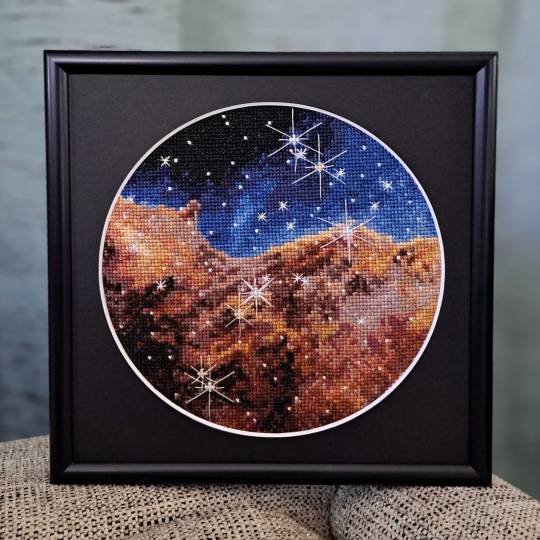
Wendy Edwards, a project coordinator with Earth Science Data Systems at NASA, created this embroidered piece inspired by Webb’s Carina Nebula image. Captured in infrared light, this image revealed for the first time previously invisible areas of star birth. Credit: Wendy Edwards, NASA. Pattern credit: Clare Bray, Climbing Goat Designs
Wendy Edwards, a project coordinator with Earth Science Data Systems at NASA, first learned cross stitch in middle school where she had to pick rotating electives and cross stitch/embroidery was one of the options. “When I look up to the stars and think about how incredibly, incomprehensibly big it is out there in the universe, I’m reminded that the universe isn’t ‘out there’ at all. We’re in it,” she said. Her latest piece focused on Webb’s image release of the Carina Nebula. The image showcased the telescope’s ability to peer through cosmic dust, shedding new light on how stars form.
Ocean Color Imagery: Exploring the North Caspian Sea
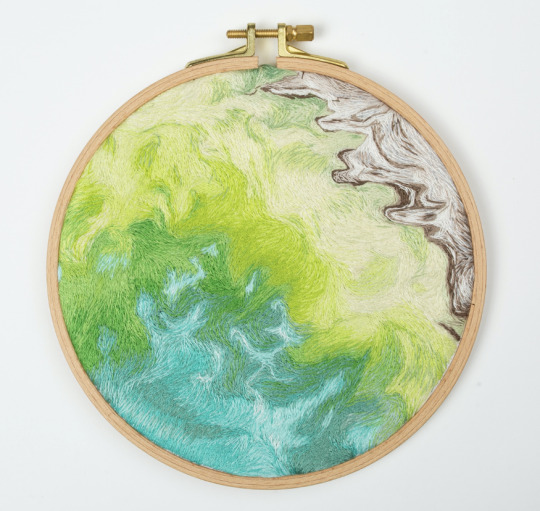
Danielle Currie of Satellite Stitches created a piece inspired by the Caspian Sea, taken by NASA’s ocean color satellites. Credit: Danielle Currie/Satellite Stitches
Danielle Currie is an environmental professional who resides in New Brunswick, Canada. She began embroidering at the beginning of the Covid-19 pandemic as a hobby to take her mind off the stress of the unknown. Danielle’s piece is titled “46.69, 50.43,” named after the coordinates of the area of the northern Caspian Sea captured by LandSat8 in 2019.

An image of the Caspian Sea captured by Landsat 8 in 2019. Credit: NASA
Two Hubble Images of the Pillars of Creation, 1995 and 2015
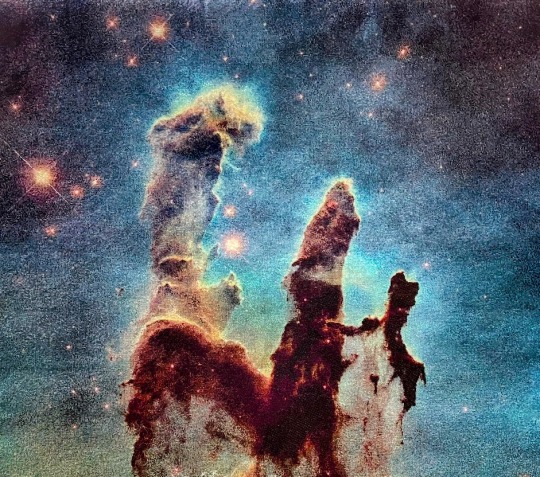
Melissa Cole of Star Stuff Stitching created an embroidery piece based on the Hubble image Pillars of Creation released in 1995. Credit: Melissa Cole, Star Stuff Stitching
Melissa Cole is an award-winning fiber artist from Philadelphia, PA, USA, inspired by the beauty and vastness of the universe. They began creating their own cross stitch patterns at 14, while living with their grandparents in rural Michigan, using colored pencils and graph paper. The Pillars of Creation (Eagle Nebula, M16), released by the Hubble Telescope in 1995 when Melissa was just 11 years old, captured the imagination of a young person in a rural, religious setting, with limited access to science education.

Lauren Wright Vartanian of the shop Neurons and Nebulas created this piece inspired by the Hubble Space Telescope’s 2015 25th anniversary re-capture of the Pillars of Creation. Credit: Lauren Wright Vartanian, Neurons and Nebulas
Lauren Wright Vartanian of Guelph, Ontario Canada considers herself a huge space nerd. She’s a multidisciplinary artist who took up hand sewing after the birth of her daughter. She’s currently working on the illustrations for a science themed alphabet book, made entirely out of textile art. It is being published by Firefly Books and comes out in the fall of 2024. Lauren said she was enamored by the original Pillars image released by Hubble in 1995. When Hubble released a higher resolution capture in 2015, she fell in love even further! This is her tribute to those well-known images.
James Webb Telescope Captures Pillars of Creation

Darci Lenker of Darci Lenker Art, created a rectangular version of Webb’s Pillars of Creation. Credit: Darci Lenker of Darci Lenker Art
Darci Lenker of Norman, Oklahoma started embroidery in college more than 20 years ago, but mainly only used it as an embellishment for her other fiber works. In 2015, she started a daily embroidery project where she planned to do one one-inch circle of embroidery every day for a year. She did a collection of miniature thread painted galaxies and nebulas for Science Museum Oklahoma in 2019. Lenker said she had previously embroidered the Hubble Telescope’s image of Pillars of Creation and was excited to see the new Webb Telescope image of the same thing. Lenker could not wait to stitch the same piece with bolder, more vivid colors.
Milky Way

Darci Lenker of Darci Lenker Art was inspired by NASA’s imaging of the Milky Way Galaxy. Credit: Darci Lenker
In this piece, Lenker became inspired by the Milky Way Galaxy, which is organized into spiral arms of giant stars that illuminate interstellar gas and dust. The Sun is in a finger called the Orion Spur.
The Cosmic Microwave Background
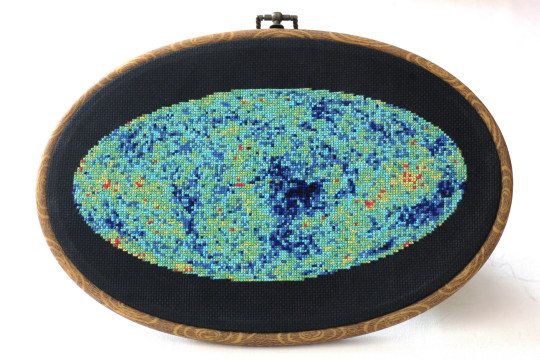
This image shows an embroidery design based on the cosmic microwave background, created by Jessica Campbell, who runs Astrostitches. Inside a tan wooden frame, a colorful oval is stitched onto a black background in shades of blue, green, yellow, and a little bit of red. Credit: Jessica Campbell/ Astrostitches
Jessica Campbell obtained her PhD in astrophysics from the University of Toronto studying interstellar dust and magnetic fields in the Milky Way Galaxy. Jessica promptly taught herself how to cross-stitch in March 2020 and has since enjoyed turning astronomical observations into realistic cross-stitches. Her piece was inspired by the cosmic microwave background, which displays the oldest light in the universe.

The full-sky image of the temperature fluctuations (shown as color differences) in the cosmic microwave background, made from nine years of WMAP observations. These are the seeds of galaxies, from a time when the universe was under 400,000 years old. Credit: NASA/WMAP Science Team
GISSTEMP: NASA’s Yearly Temperature Release

Katy Mersmann, a NASA social media specialist, created this embroidered piece based on NASA’s Goddard Institute for Space Studies (GISS) global annual temperature record. Earth’s average surface temperature in 2020 tied with 2016 as the warmest year on record. Credit: Katy Mersmann, NASA
Katy Mersmann is a social media specialist at NASA’s Goddard Space Flight Center in Greenbelt, Md. She started embroidering when she was in graduate school. Many of her pieces are inspired by her work as a communicator. With climate data in particular, she was inspired by the researchers who are doing the work to understand how the planet is changing. The GISTEMP piece above is based on a data visualization of 2020 global temperature anomalies, still currently tied for the warmest year on record.
In addition to embroidery, NASA continues to inspire art in all forms. Check out other creative takes with Landsat Crafts and the James Webb Space telescope public art gallery.
Make sure to follow us on Tumblr for your regular dose of space!
#NASA#creativity#fiber art#embroidery#art#art challenge#needlework#crafts#handmade#textile art#cross stitch#stitching#inspiration#inspo#Earth#Earth science#Hubble#James Webb Space Telescope#climate change#water#nebula#stars
6K notes
·
View notes
Text
The Greenhorn Chronicles 30: Sean Jobin on Personal Story, Work, and Views in Show Jumping
The Greenhorn Chronicles 30: Sean Jobin on Personal Story, Work, and Views in Show Jumping
Publisher: In-Sight Publishing
Publisher Founding: December 1, 2014
Web Domain: http://www.in-sightpublishing.com
Location: Fort Langley, Township of Langley, British Columbia, Canada
Journal: In-Sight: Independent Interview-Based Journal
Journal Founding: August 2, 2012
Frequency: Three (3) Times Per Year
Review Status: Non-Peer-Reviewed
Access: Electronic/Digital & Open…

View On WordPress
#Double Clear LLC#Emily Rickert#Eric Lamaze#FEI#Grand Prix rider#Hickstead#Hugh Graham#Major League#Mike Grinyer#Sean Jobin#University of Guelph
0 notes
Text
As a result of the climate crisis, global warming is driving up temperatures around the world—and bumblebees, like humans, are struggling to cope with homes that can't beat the heat.
In a new article published in Frontiers in Bee Science, scientists identify rising heat as a potential culprit for the decline in bumblebee populations worldwide, compromising bumblebees' ability to construct livable nests in which healthy larvae can develop.
"The decline in populations and ranges of several species of bumblebees may be explained by issues of overheating of the nests and the brood," said Dr. Peter Kevan of the University of Guelph, Canada, lead author of the article.
Continue Reading.
131 notes
·
View notes
Text
For the next year, this is what Alexandra Mussar will call home: a cramped bedroom with water damage and dysfunctional sinks, in a house shared with six other students. For this, she's paying $840 every month.
This isn't how she pictured her university housing experience, but after six long months hunting for somewhere to live, she says she felt she had to settle.
"There were no other options. This was my last resort," she said. "It was either that or I was couch surfing for the next year."
Across the country, students are sharing similar stories. The soaring rents that have hit some of Canada's biggest cities have also walloped college and university towns, with little relief in sight. Take Guelph, Ont., where the latest data shows the average cost for a one bedroom apartment has spiked to $2,095 per month in June, up 27 per cent from the same time last year. [...]
Continue Reading.
Tagging: @politicsofcanada, @vague-humanoid
337 notes
·
View notes
Note
do you know a lot of canadian universities? like brock, mcmaster, guelph?
Yes??? I… live … here?????
31 notes
·
View notes
Text
Fairly hyperventilating this fine Sunday afternoon. The L.M. Montgomery Institute continues to bring my soul unfettered joy awareness to access to ‘additive’ books about Maud’s work, and I’m ‘thrilling all over’ to get my hands on this one:
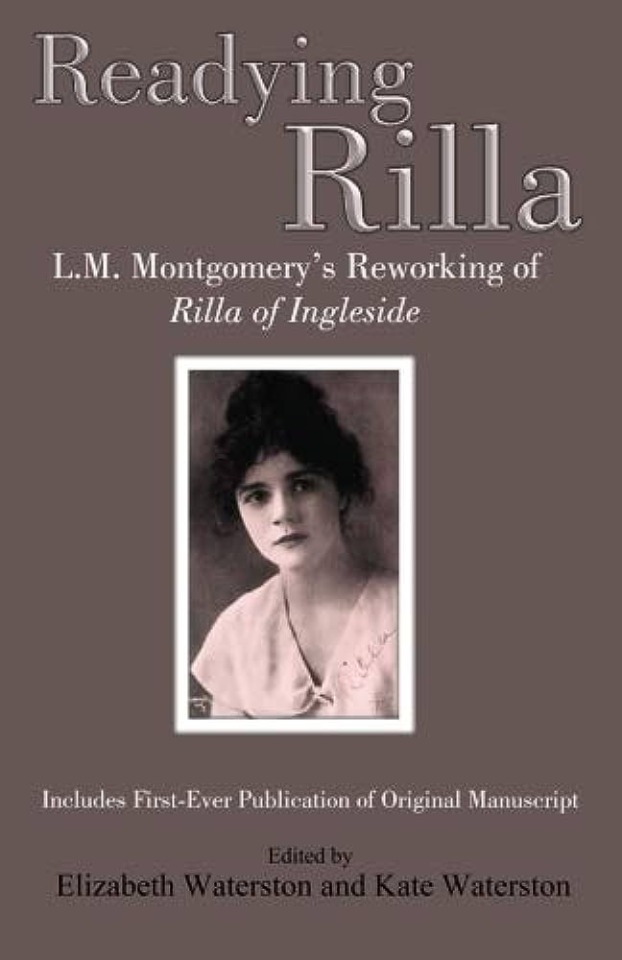
ORIGINAL manuscript, you say? The one that was an untrimmed 518 pages long???? And so I checked the description:
“Rilla of Ingleside, L.M. Montgomery’s 1921 novel about the Canadian home-front during World War I, is both moving and at times very funny. Montgomery’s original handwritten manuscript of 518 pages, along with 71 pages of notes, survives today, housed at the University of Guelph. The manuscript has been painstakingly rendered in a readable format by Kate Waterston, and is available here, with an introduction by Montgomery expert Elizabeth Waterston. This edition enables us to witness the process of Montgomery’s literary refinement as she edited her own work.” READYING RILLA
I wonder if the University of Guelph will let you just touch something (anything!) of Mauds, if you ask nicely enough!
Additionally, Elizabeth H. Waterson is a sweet little angel of a Scholar, with as much love in her her heart for Maud and Mauds work as one can possibly fit in, and she recently celebrated her 101st birthday!
In case anyone else is interested, you may write to her at:
Elizabeth H. Waterston
9436 Trinity Circle
Bradenton, FL 34210
She apparently LOVES to hear from Maud fans, and I’m leaving my house in like ten minutes to go find some extra cute stationary to write her some essentially neurotic fan-mail that’ll probably leave her questioning a public address.
#am i hoping there’s some added walter content to be scared up in this manuscript?#well yeah#👀#rilla of ingleside#lucy maud montgomery#elizabeth waterson
85 notes
·
View notes
Text
Unit 02 Blog Post
When I envision my ideal role as an environmental interpreter, I envision myself working with young learners, and I see myself teaching subjects like zoology and entomology. In previous experiences I've had working with children, I have found immense gratification in fostering an interest in science. In the context of environmental interpretation, I believe that nurturing a love for nature and interest in wildlife would provide me with a similar sense of fulfillment.
This past summer, I had the opportunity to work as a community presenter for the charity Scientists in School, where I traveled around the GTA conducting hands-on STEM workshops for school-age kids. The most rewarding part of that experience was witnessing the eyes of the children I was working with light up as they discovered the wonders of science beyond what is taught in a classroom. I believe that environmental interpretation for children could evoke the same excitement, making it an ideal career path for me.
Today’s children are increasingly influenced by technology and as a result are often spending less time outdoors, likely missing out on many opportunities to create personal connections in nature. I believe this generation would greatly benefit from engaging with nature through environmental interpretation. Teaching them to respect and appreciate their natural surroundings also fosters empathy—an essential component of their development.
To thrive in a role teaching children, several key skills are essential. First, being prepared and understanding the subject matter is crucial. Children are so inquisitive; they are always asking (sometimes unexpected) questions, so being able to answer them in an engaging and age-appropriate manner is super important. Next, strong presentation and communication skills are also necessary to keep young audiences with short attention spans engaged and interested. Patience is another important quality; kids often take more time to grasp concepts, and so encouraging their curiosity requires a supportive approach. Lastly and perhaps most importantly, being passionate about the subject matter is essential. Children are perceptive and can sense when someone lacks enthusiasm for what they are teaching. To truly engage them, one must authentically demonstrate spirit and passion for the environmental facet they are interpreting.
I am particularly interested in an environmental interpretation role that would focus on fields like zoology and entomology, which I have studied while here at the University of Guelph. Specifically, courses I have taken at Guelph that focused on insects have fundamentally changed my perspective on these creatures and highlighted their vital role in our ecosystems. I would love to help children understand that not all bugs are scary and gross; many are fascinating and play crucial roles in the environment. With a focus on those fields, an environmental interpretation role about insects or wildlife could happen in a number of places, such as nature centers, botanical gardens, zoos and aquariums, local parks, or even schools and community centers. One that I think would work best for this role would be botanical gardens, which often have butterfly gardens and insect exhibits — the perfect environment for doing guided tours and showcasing insects up-close. I would love to teach about their physiology, their roles in pollination and agriculture, and help remove some common negative perceptions of insects. I personally have visited many butterfly sanctuaries and have really enjoyed my time there — the employees always have really interesting stories and information to share about the creatures they care for. I just recently visited one this summer with my housemates, so I have included some pictures from that below!
Children possess an innate eagerness to learn and explore, and I am excited by the concept of an environmental interpretation role that would nurture that desire. The prospect that I could inspire even a tiny interest in nature and wildlife would be immensely rewarding. This is why I believe that a role as an environmental interpreter focused on young learners, combined with subjects I am passionate about like zoology or entomology, would be the perfect fit for me.




10 notes
·
View notes
Text
Unit 01 - My Relationship With Nature
My love for nature has undoubtedly always been present throughout my life.
In my earlier years of life, I remember nature as simply a place to have fun and explore. I remember how much my mom enjoyed taking me on hikes and to parks, but as a child I had yet to understand and develop a deeper meaning attached to it. It was simply something that existed outside of me, not as much something that I was connected to on more than a physical level. I absolutely loved being in nature as a kid, and I was outside often and I am so grateful to have those memories today.
Moving forward into my teenage years, I had started attending a summer camp and went on to do volunteer work as an older teen. This camp is where my relationship with nature had deepened significantly. We were outside constantly at camp, and I quickly realized my relationship with nature had become much more than physical. Spending such a large amount of time in nature, I realized the comfort it brought me and how much I actually valued my time in it. For me it had such a impactful calming and grounding effect and I began to understand that my relationship with nature had become so much more than just physical. My time at camp deepened my love for the outdoors so greatly and I’ll never forget that. My favourite part was gathering with everybody in the evening for a campfire with the view of hills, horses, and trees behind us.

Evenings at summer camp.
More recently, my relationship with nature has further grown through my work in conservation areas throughout Niagara. I began to learn more about species, plants, conservation practices and nature preservation and was able to tie it with my own schooling at the University of Guelph. I had realized nature truly is all around us and the increasing importance it has had throughout my life. This is where the concept of “a sense of place”, as mentioned in our textbook, is something I had come to recognize through the guidance and teachings of others. Working in conservation areas, I had mentors passionate about the deep importance of the natural world, and all their work revolved around protecting nature that they loved so deeply. These mentors instilled in me a deep appreciation for natures more emotional gifts at the parks I worked at and I found this newfound sense of place to continue to remind me of my appreciation wherever I go, it is why I am so connected with protecting nature today.

Sunset view at one of the parks I worked at.
In working through numerous environmental and biological classes at the University of Guelph, I understand that nature is so much more than a backdrop to our lives. My classes have helped me understand the complexity and interconnectedness of all living organisms and environments and I have become fascinated with these topics.
Today, my relationship with nature is one of love and gratitude. It is still evolving, but I now see nature as not only a source of adventure, but as a crucial part of my mental and physical well-being. I also find that my sense of place has expanded beyond the parks of where I work. With the knowledge from my classes, I know just how connected nature is throughout the entire world and the deep importance of protecting it and it is something I want to help protect for the rest of my life.
Alexandra
7 notes
·
View notes